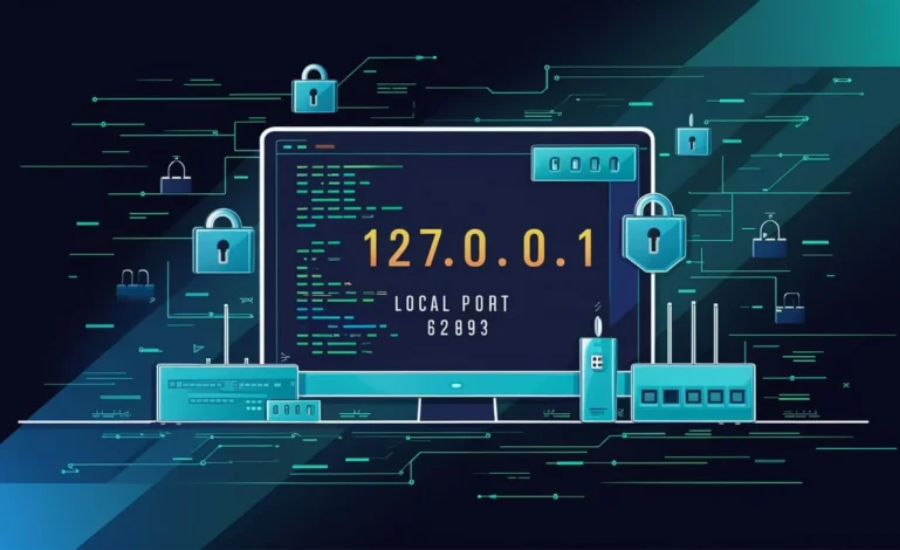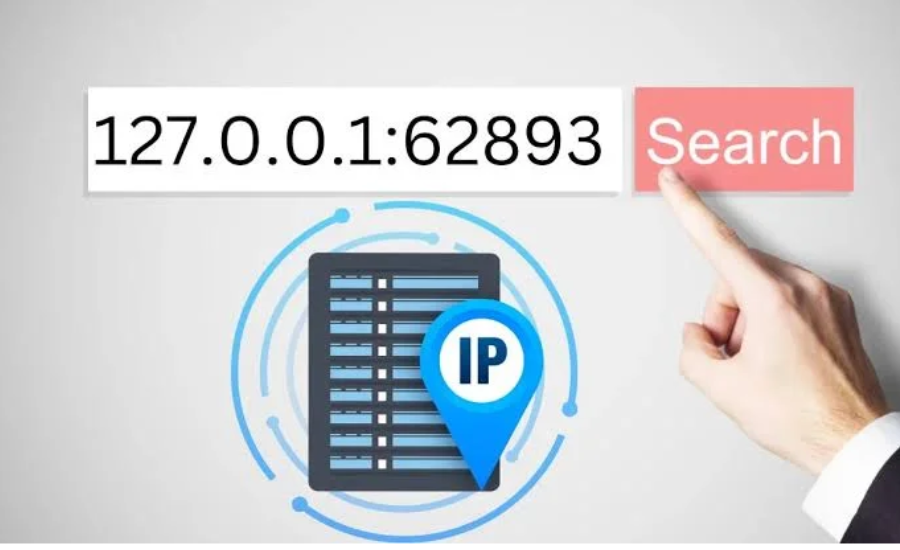127.0.0.1:62893: An In-Depth Exploration of the Loopback Address
In our modern digital landscape, the importance of IP addresses and port numbers cannot be overstated. Among these, 127.0.0.1:62893 holds a distinct place as a loopback address, enabling local communication within a machine. This comprehensive guide delves into the purpose, functionality, and key applications of 127.0.0.1, with a closer look at port 62893, to highlight its importance for testing, security, and network troubleshooting.
Understanding 127.0.0.1:62893 : The Loopback Address

What is the Loopback Address?
The IP address 127.0.0.1, known as the “loopback address,” is a unique address within the IPv4 address range reserved for internal communications on a device. It essentially allows the system to “loop back” to itself, simulating a network connection within the device. Rather than reaching out to other machines, traffic directed to this address stays within the originating device, making it an indispensable tool for localized processes.
How 127.0.0.1:62893 Facilitates Self-Communication
When data is sent to 127.0.0.1, it doesn’t exit the device or interact with external networks. Instead, it travels through the device’s network stack as though it were a regular network request but ultimately circles back to the originating device. This makes it ideal for processes that require network-like behavior without external access.
Why 127.0.0.1:62893 is Crucial for Developers and Engineers

- Testing and Debugging:
Developers often rely on 127.0.0.1 to test web applications, APIs, and other services locally. Since it doesn’t require any connection to outside networks, the loopback address provides a safe space to validate code functionality and check for errors before deployment. This is particularly useful for catching issues in the early stages of development. - Isolated Environment for Application Configuration:
Configuring applications can be tricky, and the loopback address offers a protected environment for setup and testing. System and network engineers can verify how applications behave without affecting any live or production environments. This makes it easier to optimize configurations in a risk-free setting. - Enhanced Security:
Since traffic to 127.0.0.1 stays confined to the device, using this address during development keeps sensitive data secure from outside threats. It prevents potential exposure to vulnerabilities or unwanted access, making it a preferred choice for secure testing.
Applications of 127.0.0.1:62893 in System Diagnostics and Maintenance
The loopback address also supports network diagnostics. IT professionals use it to verify if the TCP/IP protocol stack—the foundational technology behind network communication—is functioning correctly on the device. By pinging 127.0.0.1, administrators can confirm that the device’s networking capabilities are intact. If the loopback address doesn’t respond, it often points to issues within the network stack that may require immediate attention.
Configuring Software in an Isolated Setting
Another key function of the loopback address is in setting up and managing software environments. By keeping all network traffic within the device, the loopback address lets engineers configure and refine software settings without risking disruptions to other systems. This makes it possible to adjust software behavior, test patches, and make adjustments in a controlled, local context.
Supporting Local Development Servers

127.0.0.1 also plays a significant role in hosting local development servers, such as web servers or database instances, on a developer’s own machine. These servers can be accessed through 127.0.0.1 to simulate how an application will interact with a server in a real-world environment, making it simpler to test and refine before going live.
Why the Loopback Address is Important
The loopback address 127.0.0.1 offers several core advantages:
- Testing and Development: Often used by developers, this address allows applications to be tested locally, which is vital for code validation before live deployment.
- Diagnostics and Troubleshooting: IT professionals utilize 127.0.0.1 to verify TCP/IP protocol behavior on a single device, making it easier to identify and fix problems.
- Security Advantages: By limiting data flow to the local device, the loopback address minimizes exposure to external threats during development.
An Overview of Port 62893
Ports serve as identifiers for different services and applications on a device, with port 62893 being among the ephemeral, or temporary, ports commonly used for dynamic connections.
Key Aspects of Port 62893
Port 62893 is classified as an ephemeral, or dynamic, port, meaning it is used for temporary connections rather than being tied to a specific, long-term application. This makes it highly useful in development, testing, and even troubleshooting, where flexibility and rapid allocation are key. Let’s dive into the main characteristics that make Port 62893 valuable.
Dynamic Allocation
Port 62893 falls into the category of dynamically allocated ports, commonly referred to as ephemeral ports. Unlike well-known, fixed ports (such as Port 80 for HTTP or Port 443 for HTTPS), ephemeral ports are generally assigned on an as-needed basis by the operating system. Here’s why dynamic allocation is advantageous:
- Temporary Usage: Since ephemeral ports are not bound to specific services, they can be used for short-term connections and freed up afterward. This is particularly useful for tasks like testing or intermittent data transfers, where ongoing connection isn’t required.
- Efficient Resource Management: By only being assigned when needed, dynamic allocation helps in conserving port resources, minimizing potential conflicts, and keeping the network organized. For applications that don’t need a constant network connection, this efficiency is invaluable.
- Supports Connection Scaling: Because ports like 62893 are assigned dynamically, they can be used to scale connections in large systems or multi-threaded applications, allowing each new request to use a unique, temporary port for its session.
Flexible Utility Across Protocols
One of the distinguishing features of Port 62893 is its ability to support multiple protocols. While many well-known ports are tied to specific services (like HTTP or FTP), ephemeral ports are free to operate across various protocols:
- Protocol Versatility: Port 62893 can be used for different types of data transfer protocols, including HTTP, FTP, and more. This flexibility allows developers to test various network interactions on a single machine, all without requiring specific ports for each protocol.
- Useful for API and Web Service Testing: Because of its protocol-agnostic nature, Port 62893 is ideal for testing APIs, web services, and microservices. Developers can run multiple tests involving different protocols without needing separate ports for each, streamlining testing processes.
- Adapts to Different Development Needs: Whether the developer needs to test a file transfer process over FTP or run HTTP requests, Port 62893 can handle it. This capability gives developers a broad, adaptable platform for network operations.
Non-Standard Assignment for Adaptable Network Operations
Ephemeral ports like 62893 differ from ports designated for specific protocols (e.g., Port 21 for FTP) because they are not locked to particular services. This non-standard assignment offers several advantages:
- Freedom for Applications to Operate Unrestrictedly: Unlike fixed ports, ephemeral ports allow applications to function without being limited to a predefined network configuration. This is particularly helpful in environments where network conditions may change or require quick adjustments.
- Minimizes Potential Conflicts: Fixed ports can sometimes lead to conflicts if multiple applications attempt to use the same port. With a dynamically assigned port like 62893, the likelihood of such conflicts is reduced, as each connection is assigned a unique, temporary port.
- Enhanced Support for Modern, Dynamic Systems: As network environments become more complex, the flexibility of non-standard ports is essential. From cloud environments to microservices, systems increasingly rely on ephemeral ports to handle dynamic communication needs without disrupting other services.
Practical Applications of Port 62893 in Development and Testing
- Short-Term Connections: Developers can use Port 62893 for applications that require brief connections, such as testing data transfer between services, without the need for a permanent port allocation.
- Multi-Protocol Testing: The port’s protocol flexibility enables it to support a range of tests on different protocols within a single local environment, making it useful for projects involving complex data exchange needs.
- Isolated Testing Environments: Port 62893 can be used in combination with the loopback address 127.0.0.1 to conduct testing within a confined setting, ensuring that applications do not impact live environments.
Benefits of Using 127.0.0.1 with Port 62893
For developers and IT administrators, the combination of the loopback address with port 62893 offers a range of benefits:
- Strengthened Security: Restricting data transmission to the local device enhances security, reducing risks from external threats.
- Streamlined Testing: Developers can conduct application testing without involving external networks, which simplifies the development process.
- Simplified Troubleshooting: Administrators can resolve network issues within a controlled environment, accelerating issue resolution.
- Resource Management: By using a temporary port like 62893, network resources are managed more efficiently, optimizing device performance.
Real-World Uses and Scenarios
For Developers
- Local Server Simulations: Enables pre-deployment testing for server applications to ensure stability and performance.
- API Testing: Provides a local setup for validating API endpoints and refining code functionality.
- Protocol Development: Allows developers to safely work on network protocols without affecting live network operations.
For System Administrators
- Network Setup: Administrators can configure and test network settings locally, avoiding unintended impacts on live systems.
- Security Testing: The loopback address enables secure vulnerability assessments within a sandbox environment.
- Service Monitoring: Administrators can oversee local services and applications to ensure optimal performance and reliability.
Key Facts About 127.0.0.1 and Port 62893
- Loopback Address: 127.0.0.1 is the designated loopback address in IPv4, allowing a device to send and receive data to itself without external network interaction.
- Self-Communication: Traffic directed to 127.0.0.1 is processed internally within the device, making it a crucial tool for local applications and testing environments.
- Development and Testing: Developers utilize the loopback address for testing applications, APIs, and services locally, ensuring code is validated in a secure environment before deployment.
- Diagnostic Tool: IT professionals use 127.0.0.1 to check the functionality of the TCP/IP protocol stack. Successful pings to this address confirm that networking components are operational.
- Secure Configuration: The loopback address enables engineers to configure and test applications without risking disruptions to live systems, ensuring a controlled setup process.
- Role in Local Servers: 127.0.0.1 is commonly used for hosting local servers, allowing developers to simulate server interactions and refine applications before going live.
- Ephemeral Port: Port 62893 is classified as an ephemeral port, meaning it is dynamically assigned for temporary connections rather than fixed to specific applications.
FAQs
Q: What is the purpose of the IP address 127.0.0.1?
A: The IP address 127.0.0.1, also known as the loopback address, allows a computer to communicate with itself. It’s primarily used for testing and troubleshooting within the same machine without accessing external networks, ensuring a secure, isolated environment for developers and system administrators.
Q: How does the loopback address 127.0.0.1 aid in network diagnostics?
A: Using 127.0.0.1, IT professionals can verify that a device’s TCP/IP protocol stack is functioning properly. By pinging the address, they can confirm that network capabilities are active on the device; if it doesn’t respond, this may indicate issues within the network stack that need addressing.
Q: Why do developers use 127.0.0.1 for testing?
A: Developers rely on 127.0.0.1 because it allows them to test applications and network behaviors locally without any external connections. This helps validate code and application setups in a secure, risk-free environment, making it easier to troubleshoot and refine software before going live.
Q: What is the role of Port 62893 in local testing?
A: Port 62893 is an ephemeral port used for temporary, short-term connections. Its dynamic nature and compatibility with multiple protocols make it ideal for development and testing, providing developers with a flexible and adaptable platform for network simulations.
Q: How does Port 62893 differ from standard ports like Port 80?
A: While standard ports like Port 80 are assigned to specific protocols (HTTP in this case), Port 62893 is an ephemeral port with no fixed protocol assignment. It’s allocated on an as-needed basis and can support various protocols, such as HTTP or FTP, making it versatile for different testing and development purposes.
Q: What security benefits does 127.0.0.1 provide?
A: Since 127.0.0.1 confines data transmission to the device itself, it significantly reduces the risk of external security threats. This containment allows developers to test sensitive data and processes without exposing them to the broader network, enhancing security during the development phase.
Conclusion
The loopback address 127.0.0.1, paired with ephemeral ports like Port 62893, provides powerful tools for development, testing, and network diagnostics. Their primary role is to facilitate isolated, secure testing environments that are essential for validating code, configuring applications, and troubleshooting network issues. By confining data flow to the device and using temporary, adaptable ports, developers and administrators can efficiently handle a range of tasks without exposing systems to potential risks. Mastering these tools can greatly enhance the productivity and security of IT operations, making 127.0.0.1:62893 a valuable resource in the world of digital networks.
Let’s keep the conversation going—subscribe now! The Appkod







